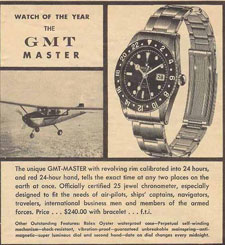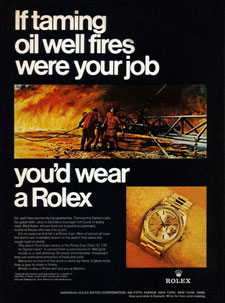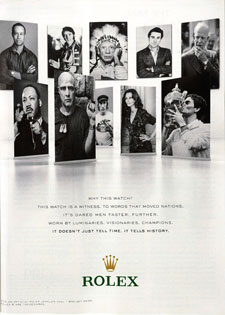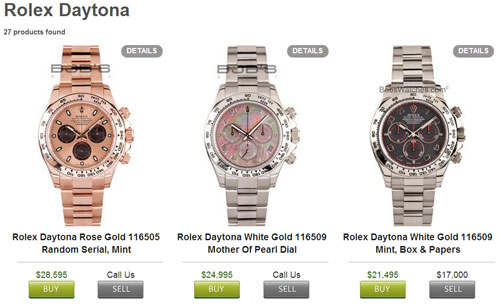Why NOT to insure a Rolex: Reasons 5-7
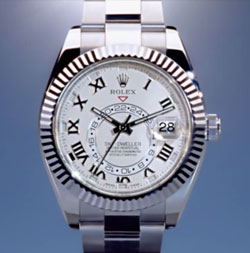 Rolex is the largest-selling luxury watch in the world. Rolex is by far the watch most likely to be scheduled. This issue looks at three more reasons why covering a Rolex may not be a good idea.
Rolex is the largest-selling luxury watch in the world. Rolex is by far the watch most likely to be scheduled. This issue looks at three more reasons why covering a Rolex may not be a good idea.
The numbering here continues from our previous issue on 12 Reasons Not To Insure a Rolex.
5. Rolex is a male-dominated risk.
There are no statistics available for the sale of Rolexes by gender, but it's a safe bet that most are sold to men. This is the company's intention.
Since its inception, Rolex has tailored its advertising to appeal to the man who wants to be seen as successful and adventure-seeking. Rolex sponsors sporting events that appeal mainly to men, such as motorcar racing.
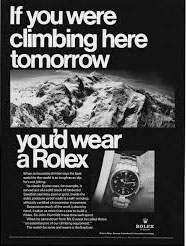 1960s Rolex ad |
|
Rolex wearers climb mountains, go deep-sea diving, fly planes and put out fires because their watches let them do that. In a contemporary ad showing figures in recent history who wore Rolex, the text says, "IT'S DARED MEN FASTER. FURTHER. WORN BY LUMINARIES. VISIONARIES. CHAMPIONS." The message is that wearing a Rolex puts you—the male reader—in this company.
Although there are many brands of luxury watches, most scheduled watches are Rolexes. And most of those scheduled Rolexes are men's. This is important for insurers because, simply put: the loss ratio is much worse for men's jewelry than for women's.
6. Sentimental value does not attach to a Rolex.
Women tend to associate their jewelry with major events in their lives—wedding, anniversary, etc. Women often receive jewelry as a gift. The jewelry then comes to represent the event and the relationship with the giver. Influenced by these associations, women tend to be careful with their jewelry and more protective of it.
A man's Rolex doesn't carry this emotional weight.
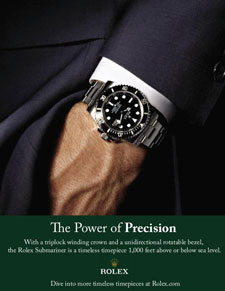 It might even be said that a luxury watch appeals to a man because a watch isn't quite jewelry. The watch may be appreciated as a finely crafted object, a wonder of technology, an exquisite machine. Rolexes are "tool watches," not adornments. A Rolex watch has excellent engineering, lends the wearer prestige and public status, but it doesn't carry much personal sentiment.
It might even be said that a luxury watch appeals to a man because a watch isn't quite jewelry. The watch may be appreciated as a finely crafted object, a wonder of technology, an exquisite machine. Rolexes are "tool watches," not adornments. A Rolex watch has excellent engineering, lends the wearer prestige and public status, but it doesn't carry much personal sentiment.
Lacking this emotional significance, a Rolex may be valuable but it's not seen as irreplaceable. Thus, men are likely to be more casual in safeguarding their jewelry. This is borne out by insurance records that show a higher loss ratio for men's jewelry. And Rolex watches are the most frequently scheduled men's jewelry.
7. Rolex collectors wheel and deal, which means changes to the policy.
As the world's largest luxury watch brand, Rolex is the brand most collected and insured. Seeking certain models or special features, collectors frequently "trade up," disposing of a watch they have in order to acquire a more desirable one.
This creates maintenance issues for an insurer. The underwriter is constantly touching the policy, as watches are added to or deleted from coverage. And a watch is more complex to describe than a solitaire engagement ring.
One source names over 30 basic lines of Rolex watches, like Daytona, Submariner, and Oyster Perpetual. Some of the lines have similar, though distinct, names—such as Explorer and Explorer II. Each line was produced in many versions; one line came in 48 different models, each with its own model number. Rolex has made dozens of movements, so the movement number must be recorded. There are also serial numbers, and the metals used for the various parts—dial, bezel, band, etc. In addition, any given watch may have unique features added, such as gems, each of which must be described in detail. All these features affect value and should be recorded for proper coverage.
And, though this may seem obvious, all the details must be accurate. With watches this is no small feat, since most appraisers are not trained in recognizing such watch details or distinguishing authentic from counterfeit parts. The appraisal of a Rolex is a whole separate concern, which we will discuss in a future issue of JII.
FOR AGENTS & UNDERWRITERS
The loss ratio for men's jewelry is much worse than for women's. And a watch, usually a Rolex, is the most frequently scheduled item of men's jewelry.
Fine watches are identified by model and serial number, which should be given on the appraisal. Most manufacturers have separate model numbers for parts of the watch, such as the dial, bezel and band. All these numbers should be on the appraisal.
In addition, Rolex and other high-end watches are available with all sorts of diamond and gemstone accessory parts, all of which can carry separate model and part numbers. And these are far more costly than typical after-market parts added by non-Rolex sources.
Any gems on the watch, and the metal of each watch part, should be described in the same detail as for any other piece of gem jewelry. As you can imagine, detailed reporting on a watch encrusted with gems is extremely important to insurers.
Always ask for Rolex warrantee papers and a sales receipt. Rolexes purchased from a seller other an authorized dealer are considered by Rolex to be second-hand and are not covered by the company's warrantee.
FOR ADJUSTERS
Check for warrantee and other papers to be sure the watch is a genuine Rolex before pricing a replacement.
Watches, like cars (and unlike other jewelry), are machines that suffer wear and tear and do depreciate over time. A 10-year-old Rolex does not have the value of a new Rolex of that model. As with a car, so with a watch—the value of the replacement should take into account the age and condition of the property.
Be mindful of the moral hazard of an excessively high valuation, which can cause the insured to try to come out ahead by "losing" the jewelry. This is a more likely danger with men's watches because there is little sentimental attachment to the item.
There is a huge market for vintage (i.e., used) watches. An appraiser judging the value of a used Rolex can consult pricing services for vintage watches.
A future issue of JII will take a more detailed look at watch appraisals and the concerns they present for underwriters and adjusters.
©2000-2025, JCRS Inland Marine Solutions, Inc. All Rights Reserved. www.jcrs.com



